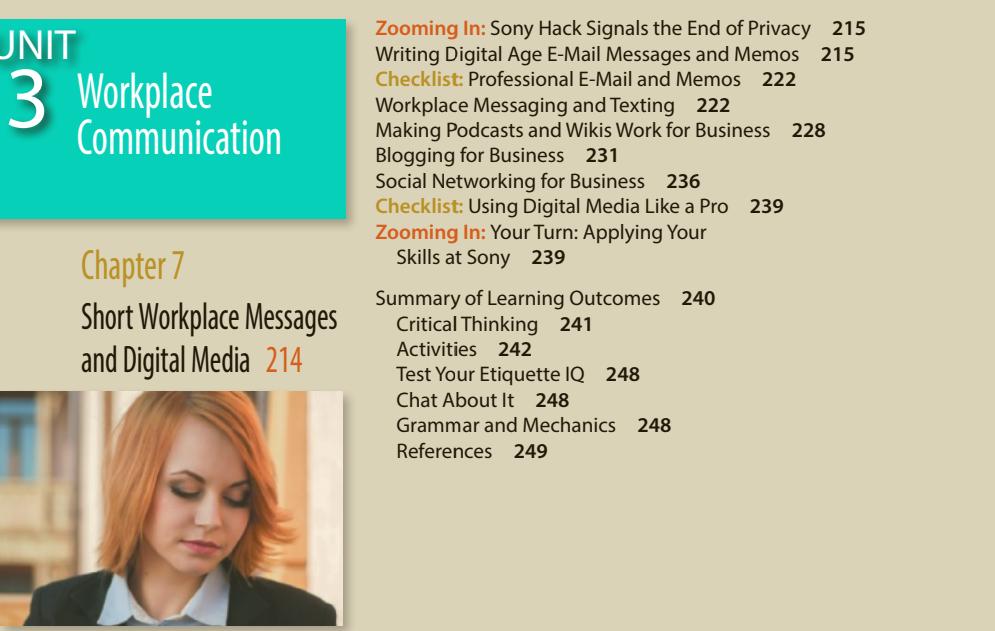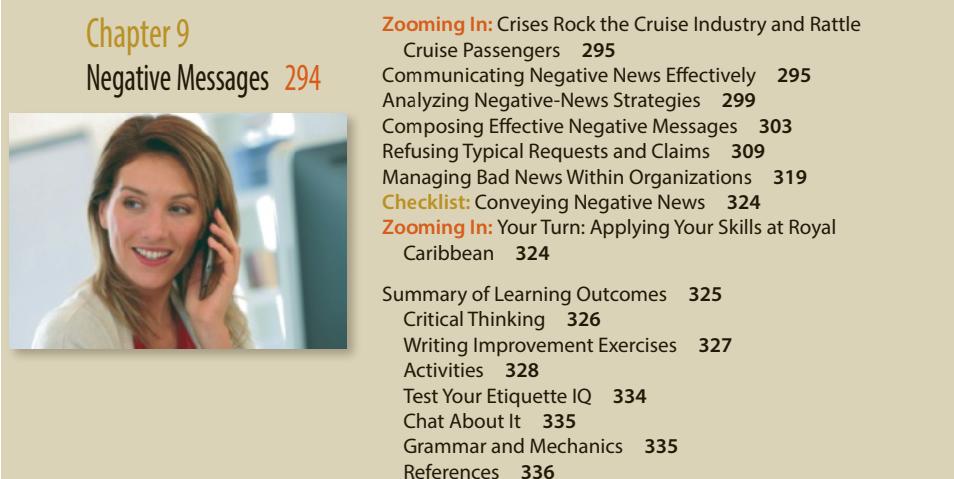བདུན་ཕྲག་རེ་བཞིན་གྱི་བཅུད་དོན།
ཡོངས་ཁྱབ།
BUSINESS COMMUNICATION
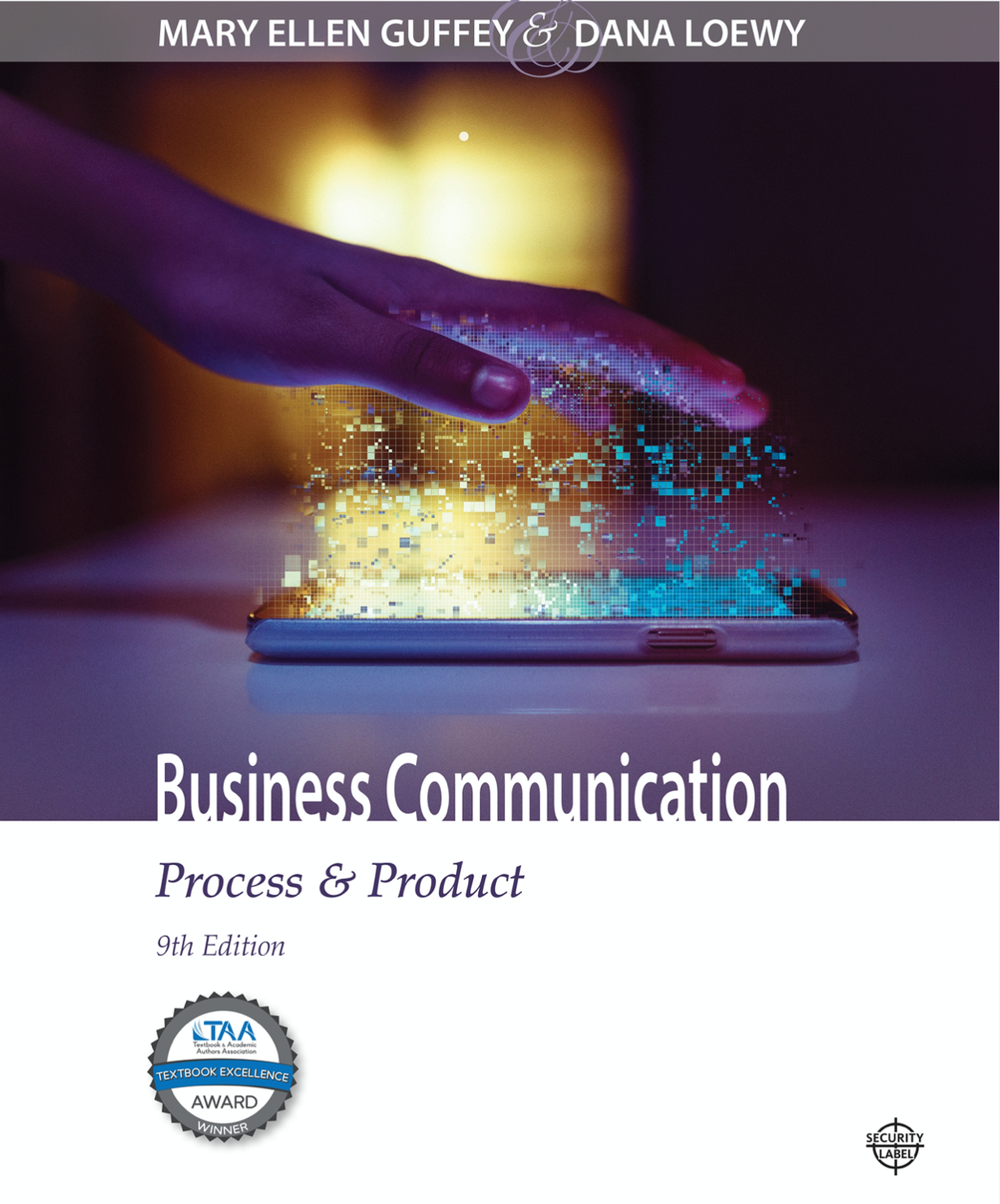
Assalamualaikum, Wr. Wb
Hallo..
Welcome to Bussiness Communication Class
Our class will start every Wednesday 10.10 am
Lecture this course:
Dr. NOVA MARDIANA, SE, MM Dr. Angga Febrian, S.E. M.Si.
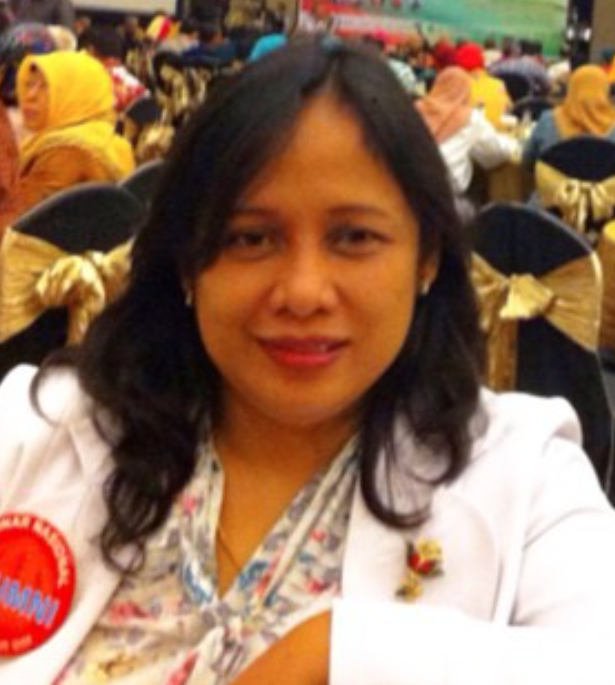

The Course about Business Communication in Digital Era. Business communication skills are absolutely essential in every professional environment. This broad-ranging group of skills covers written, verbal, and visual communication, as well as more specialized applications such as business writing, email writing, presentations, public speaking, and negotiation.
This Course about learning basic forms of business communication, business communication processes, main purposes and objectives in business communication, and be able to apply various forms of business communication as needed and in effective and effective use. efficient in facing the era of globalization.
On Complete of this course, students will be able to :
- Students are expected to have knowledge, understanding, and skills about learning basic forms of business communication, business communication processes, main purposes and objectives in business communication,
- and be able to apply various forms of business communication as needed and in effective and effective use. efficient in facing the era of globalization.
- Students are able to make good and creative presentative videos in open education learning.
e-book for Business Communication Course :

- Individual assignment
- Group assignment
Problem based group discussion in the vclass forum, The presentation video is uploaded to youtube and the link is shared on the vclass
forum, peer assessmentsClass attendance:
All class attendance is mandatory. Punctuallity at all class meetings is highly expected. One half of your class participation grade is made up of class attendance, and each unexcused absence will cause you to forfeit the attendance credit for that day. Missing more than 30 minutes of class (either through arriving late or leaving early) will count as missing the entire class. Students arriving less than 30 minutes late will earn reduced class attendance credit for that day. Excused absences are only granted in cases of serious illness (proved with physician or medical doctor letter) or grave family emergencies, and each of these situations must be documented to our satisfaction. Any student who misses his/her group presentation due to an unexcused absence will forfeit 50% of the presentation points earned by the group. If there is a written/homework assignment to complete for class (noted on the syllabus), failure to do the assignment will result in no credit for attendance that day.
Excused Absences:
The following situations are as acceptable reasons for excused absences:
a) serious illness;
b) illness or death of family member;
c) University-related trips;
d) major religious holidays;
e) other circumstances you find to be "reasonable cause for nonattendance".
For those who have an excused absence, there will be an opportunity to make up missed work and/or exams. It is the student's responsibility to inform the instructor of the absence preferably in advance, but no later than one week after it. Bring with you any medical doctor prove of your illness or other proves of your absences for verification purpose.
Range Final Mark
Grade Level
Grade Point
Status
≥76
A
4
Pass
71 – 75
B+
3,5
Pass
66 – 70
B
3
Pass
61 – 65
C+
2,5
Pass
55 – 60
C
2
Pass
50 – 54
D
1
Pass
‹ 50
E
0
Failed
Class Attendance and Participation
15%
Assignment and Group Presentation
Personal Assignment
35%
5%
Quiz 1 & 2
5%
Midterm Exam
20%
Final Exam
20%
Total
100%
Notes:
CAP : Class Attendance and Participation
AGP : Assignment and Group Presentation
Q : Quiz
MT : Mid Term
FE : Final Exam
PA : Personal Assignment
1st session; Chapter 1. Bussiness Communication in the Digital Age. Overview, RPS, Course Contract, etc
Assalamu'alaikum wr. wb.
Dear Students ...
Today our first meeting
After attending this lecture, students are expected to be able to:
- Explain how communication skills fuel career success, and understand why writing skills are vital in a digital, mobile, and social-media driven workplace.
- Identify the tools for success in the hyperconnected 21stcentury workplace;appriciate the importanceof critical thinking skillsand personal credibility in the competitivejob market of the digital age;and discuss how your education may determine your income
- Describe Significant trends in today’s dynamic, networked work environment, and recognize that social media and other communication technologies reuire excellent communication skills, in any economic climate.
-
Examine Critically the internal and external flow of communication in organizations through formal and informal channels, explain the
importance of effective media choices, and understand how to overcome typical barriers to organizational communication. - Analyze ethics in the workplace, understand the goals of ethical business communicators, and choose the tools for doing the right thing.
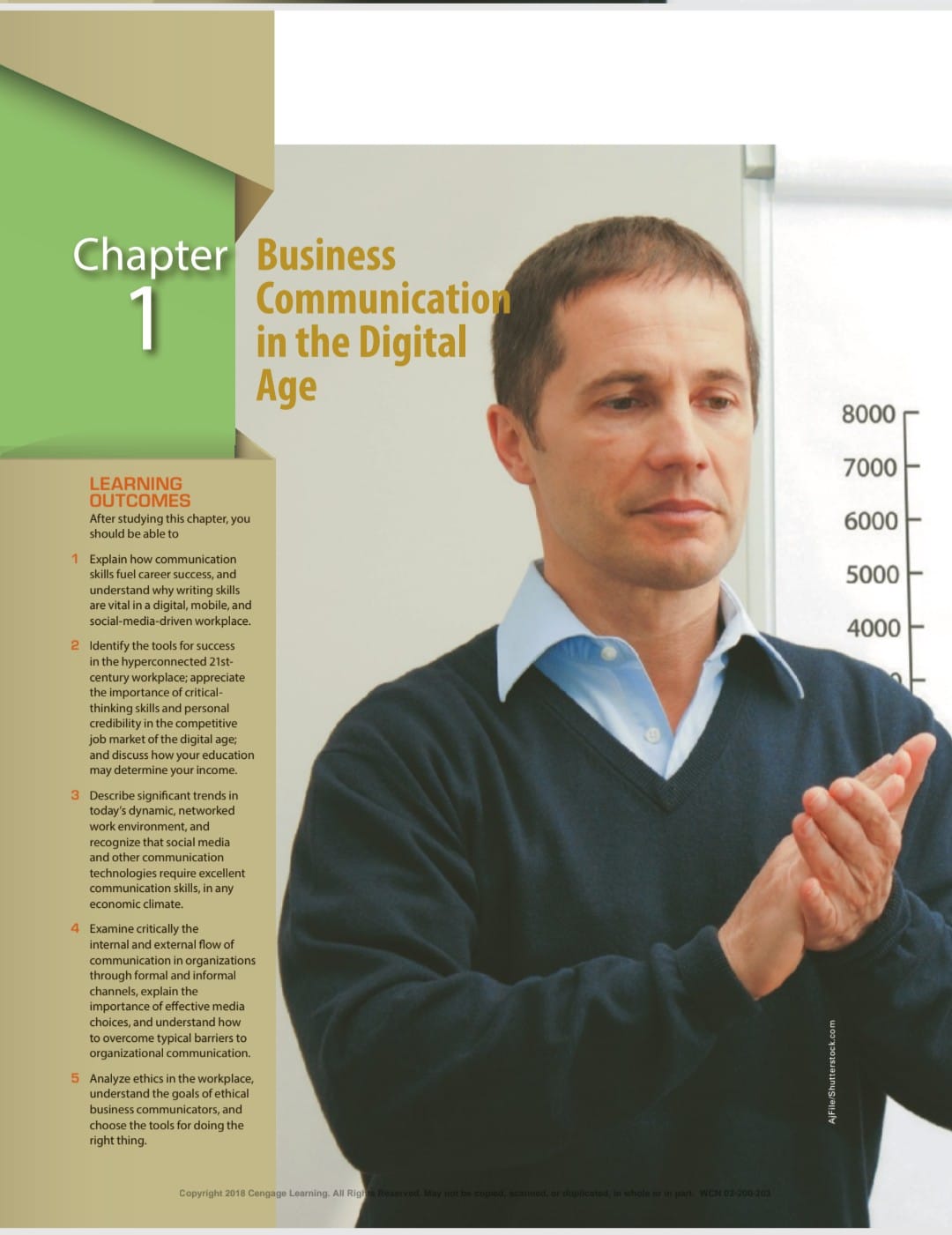
Ch 1.

Explain how communication skills fuel career success, and understand why writing skills are vital in a digital, mobile, and social-media-driven workplace? 
2nd session; Chapter 2. Professionalism: Team, Meeting, Listening, Nonverbal, and Etiquette Skills.
Assalamu'alaikum wr. wb.
Dear Students ...
After attending this class, students are expected to be able to:
- Understand the importance of teamwork in the digital era workplace, and explain how you can contribute positively to team performance.
- Discuss effective practices and technologies for planning and participating in face-toface meetings and virtual meetings.
- Explain and apply active listening techniques.
- Understand how effectives nonverbal communication can help you advance your career.
- Improve your competitive advantage by developing professionalism and business etiquette skills.
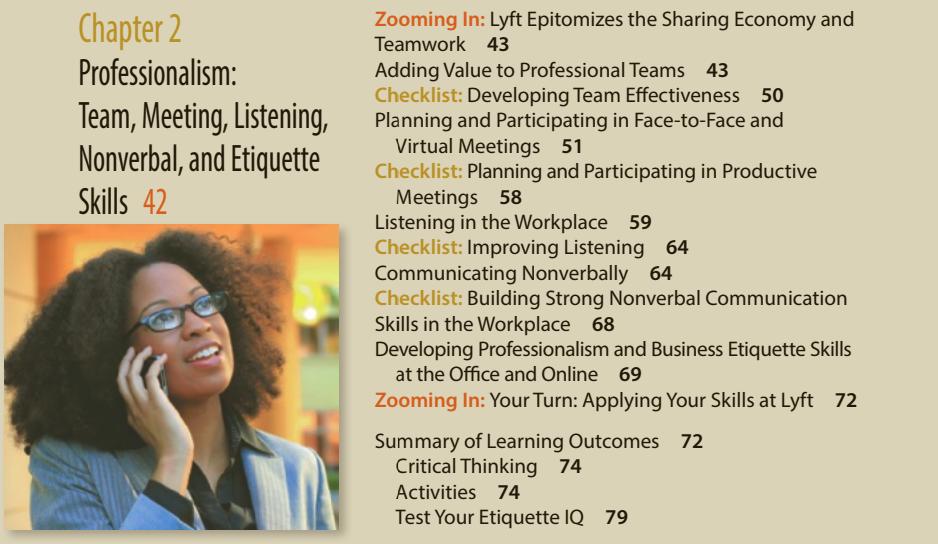
Ch 2. Professionalism: Team, Meeting, Listening, Nonverbal and Etiquette
- Answers my questions directly:
- Explain the importance of teamwork in the digital era workplace, and explain how you can contribute positively to team performance.
- Explain about effective practices and technologies for planning and participating in face-toface meetings and virtual meetings.
- Explain and apply active listening techniques.
- How effectives nonverbal communication can help you advance your career?
- Improve your competitive advantage by developing professionalism and business etiquette skills.
- Answers my questions directly:

3rd session; Chapter 3. Intercultural Communication.
Assalamu'alaikum wr. wb.
Dear Students ...
After attending this class, students are expected to be able to:
- Understand the powerful effects of globalization and the major trends fueling it.
- Define culture, name its primary characteristics, and explain the five key dimensions of culture: context, individualism, time orientation, power distance, and communication style.
- Discuss strategies for enhancing intercultural effectiveness, reflect on nonverbal intercultural communication, assess how social media affect intercultural communication, and apply techniques for successful oral and written interactions across cultures.
- Grasp the complexities of ethics across cultures, including business practices abroad, bribery, prevailing customs, and methods for coping.
- Explain the advantages and challenges of workforce diversity, and address approaches for improving communication among diverse workplace audiences.

- Explain the powerful effects of globalization and the major trends fueling it !
- Define culture, name its primary characteristics, and explain the five key dimensions of culture: context, individualism, time orientation, power distance, and communication style.
- Explain about strategies for enhancing intercultural effectiveness, reflect on nonverbal intercultural communication, assess how social media affect intercultural communication, and apply techniques for successful oral and written interactions across cultures.
- Explain the advantages and challenges of workforce diversity, and address approaches for improving communication among diverse workplace audiences !
Answers my questions:
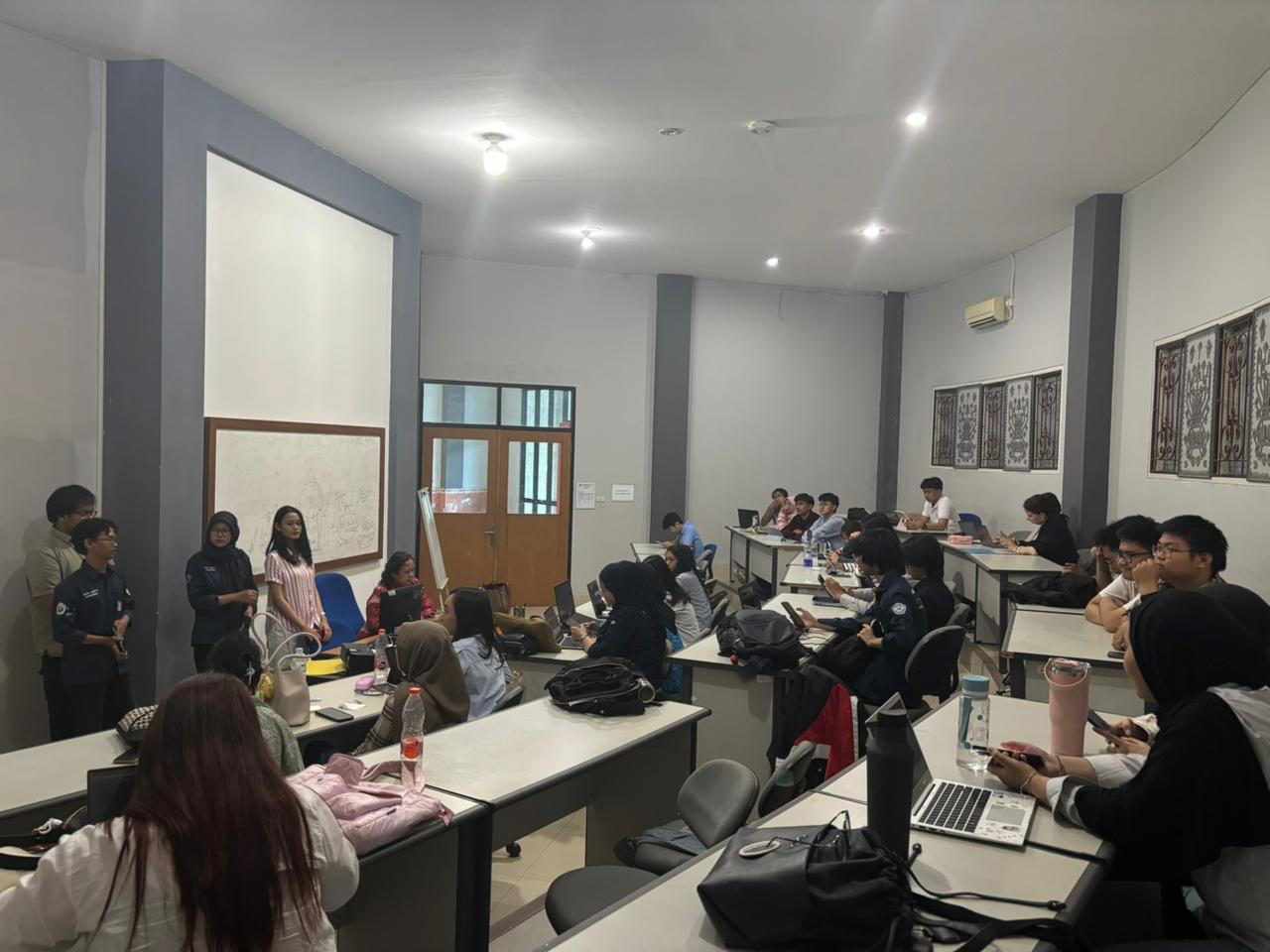
4th session; Chapter 4. Planning Business Messages
Assalamu'alaikum wr. wb.
Dear Students ...
After attending this class, students are expected to be able to:
- Understand the nature of communication and its barriers in the digital era.
- Summarize the 3-x-3 writing process and explain how it guides a writer.
- Analyze the purpose of a message, anticipate its audience, and select the best communication channel.
- Employ expert writing techniques such as incorporating audience benefits, the “you” view, conversational but professional language, a positive and courteous tone, bias-free language, plain language, and vigorous words.
- Understand how teams approach collaborative writing projects and what collaboration tools support team writing.
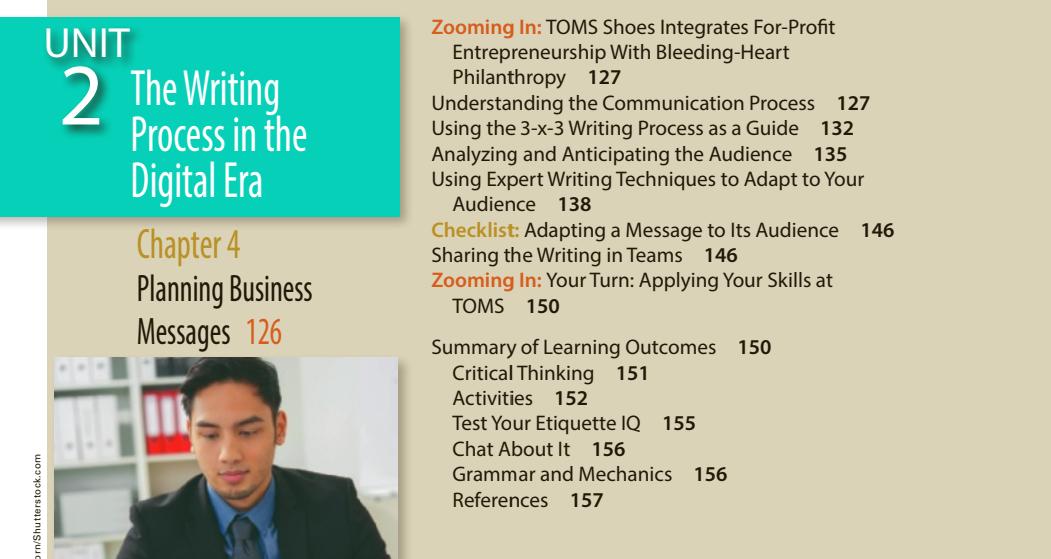
Answers my questions..
- Explain the nature of communication and its barriers in the digital era.
- Summarize the 3-x-3 writing process and explain how it guides a writer.
- How teams approach collaborative writing projects and what collaboration tools support team writing.
5th session; Chapter 5. Organizing and Drafting Business Messages Ch 6. Revising Business Messeges
Assalamu'alaikum wr. wb.Dear Students ...
After attending this lecture ch 5, students are expected to be able to:
- Apply Phase 2 of the 3-x-3 writing process, whic begins with formal and informal research to collect background information.
- Generate and organize ideas resulting from techniques such as brainstorming and brainwriting along with social media techniques such as crowdsourcing, crowdstorming, and crowdfunding.
- Compose the first draft of a message using a variety of sentence types and avoiding sentence fragments, run-on sentences, and comma splices.
- Improve your writing techniques by emphasizing important ideas, employing the active and passive voice effectively, using parallelism, and preventing dangling and misplaced modifiers.
- Draft well-organized paragraphs using (a) the direct plan to define,classify, illustrate, or describe; (b) the pivoting plan to compare and contrast; or (c) the indirect plan to explain and persuade. Paragraphs should include (a) topic sentences, (b) support sentences, and (c) transitional expressions to build coherence.
After attending this lecture, Ch 6. students are expected to be able to:
- Polish business messages by revising for conciseness, which includes eliminating flabby expressions, long lead-ins, there is/are and it is/was fillers, redundancies, and empty words, as well as condensing for microblogging.
- Improve clarity in business messages by keeping the ideas simple, slashing trite business phrases, dropping clichés scrapping slang and buzzwords, rescuing buried verbs, and restraining exuberance.
- Enhance readability by understanding document design including the use of white space, margins, typefaces, fonts, numbered and bulleted lists, and headings.
- Recognize proofreading problem areas, and apply effective techniques to catch mistakes in both routine and complex documents.
- Evaluate a message to judge its effectiveness.
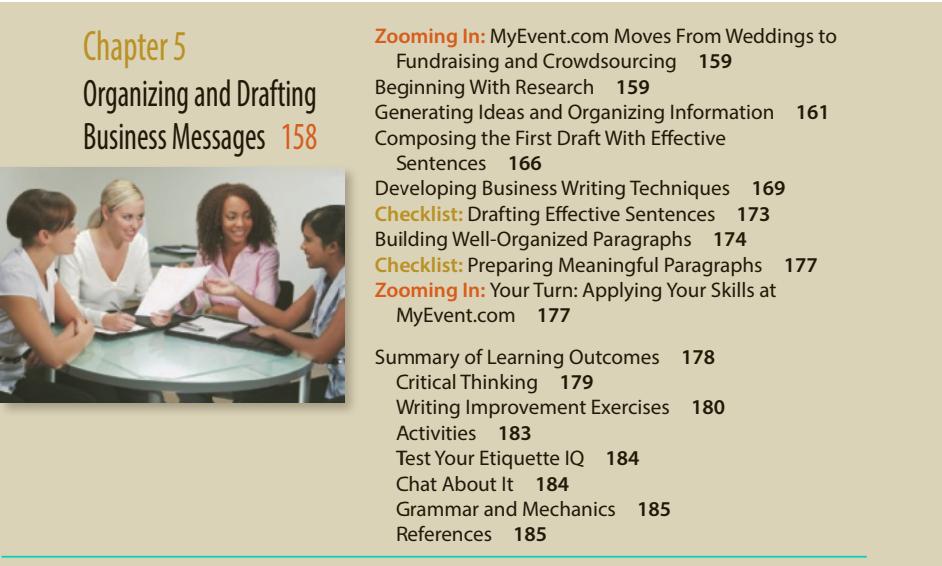
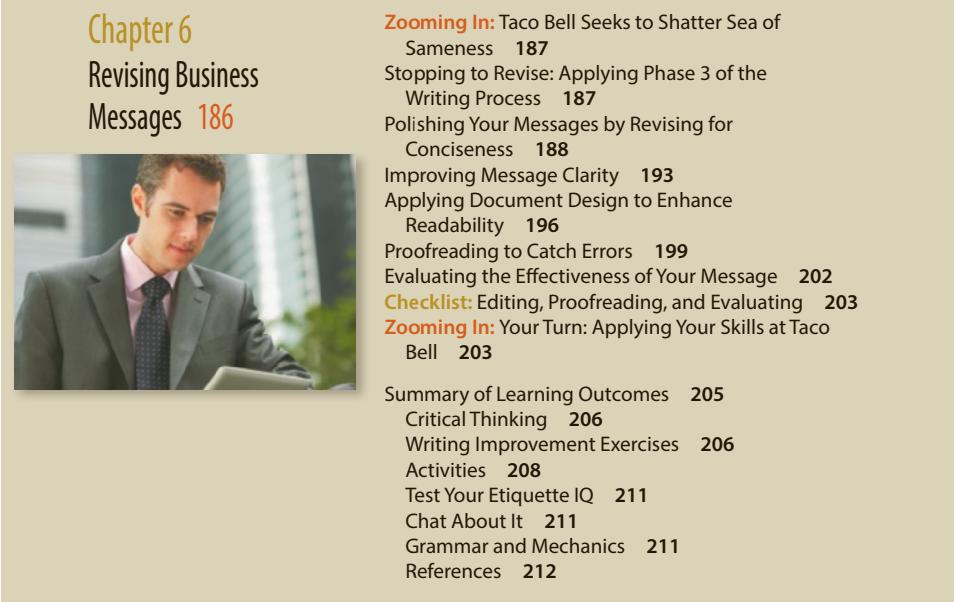
Answers my Questions...
1. Explain how to compose the first draft of a message using a variety of sentence types and avoiding sentence fragments, run-on sentences, and comma splices.
2. Explain how to improve your writing techniques by emphasizing important ideas, employing the active and passive voice effectively, using parallelism, and preventing dangling and misplaced modifiers.
3. Explain how to Draft well-organized paragraphs using (a) the direct plan to define,classify, illustrate, or describe; (b) the pivoting plan to compare and contrast; or (c) the indirect plan to explain and persuade. Paragraphs should include (a) topic sentences, (b) support sentences, and (c) transitional expressions to build coherence.
4. Explain how to polish business messages by revising for conciseness, which includes eliminating flabby expressions, long lead-ins, there is/are and it is/was fillers, redundancies, and empty words, as well as condensing for microblogging.
5. Explain how to improve clarity in business messages by keeping the ideas simple, slashing trite business phrases, dropping clichés scrapping slang and buzzwords, rescuing buried verbs, and restraining exuberance.
6. Explain how to recognize proofreading problem areas, and apply effective techniques to catch mistakes in both routine and complex documents.
7. Expalin how to evaluate a message to judge its effectiveness.
6th session; Chapter 7. Short Workplace Messages and Digital Media
dear students...
After attending this lecture, students are expected to be able to:
- Understand e-mail, memos, and the professional standards fo their usage, structure, an format in the digital era workplace.
- Explain workplace insta messaging and texting a well as their liabilities and best practices.
- Identify professional applications of podcasts and wikis, and describe guidelines for their use.
- Describe how businesse use blogs to connect wit internal and external audiences, and list best practices for professiona blogging.
- Define business uses of social networking.
7th session; Chapter 8. Writing Requests for Routine and Positive Messages
After attending this lecture CH 8, students are expected to be able to:
- Understand the channels through which typical positive messages travel in the digital era e-mails, memos, and business letters and apply the 3-x-3 writing process.
- Compose direct messages that make requests, respond to inquiries online and offline, and deliver step-by- step instructions.
- Prepare contemporary messages that make direct claims and voice complaints, including those posted online.
- Create adjustment messages that salvage customers’ trust and promote further business.
- Write special messages that convey kindness and goodwill.
8th session; MID TERM
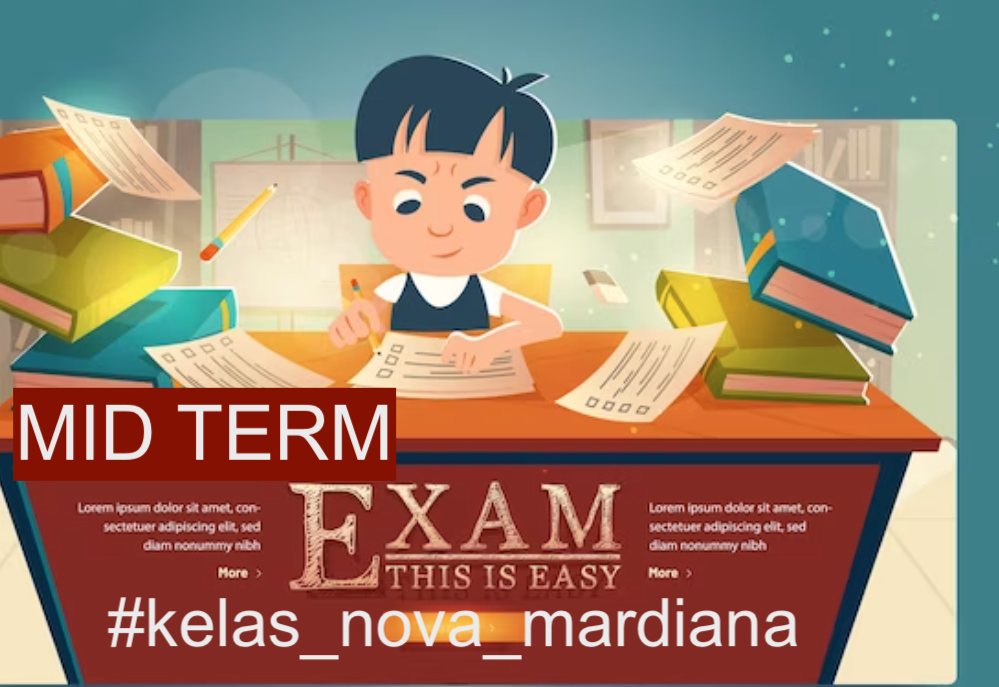
9th session; Chapter 9. Negative Messages
After attending this lecture, students are expected to be able to:
- Understand the strategies of business communicators in conveying negative news, apply the 3-x-3 writing process, and avoid legal liability.
- Distinguish between the direct and indirectstrategies in conveying unfavorable news.
- Explain the components of effective negative messages, including opening with a buffer, apologizing, showing empathy, presenting the reasons, cushioning the bad news, and closing pleasantly.
- Apply effective techniques for refusing typical requests or claims as well as for presenting bad news to customers in print or online.
- Describe and apply effective techniques for delivering bad news within organizations.
10th session; Chapter 10. Persuasive and Sales Messages
After attending this lecture, students are expected to be able to:
- Explain digital age persuasion, identify timeproven persuasive techniques, and apply the 3-x-3 writing process to persuasive messages in print and online.
- Describe the traditional four-part AIDA strategy for creating successful persuasive messages, and apply the four elements to draft effective and ethical business messages.
- Craft persuasive messages that request actions, make claims, and deliver complaints.
- Understand interpersonal persuasion at work, and write persuasive messages within organizations.
- Create effective and ethical direct-mail and email sales messages.
- Apply basic persuasive techniques in developing compelling press releases.
11st session; Chapter 11. Reporting in the Digital Age Workplace
After attending this lecture, students are expected to be able to:
- Explain informational and analytical report functions, organizational strategies, and writing styles as well as typical report formats.
- Apply the 3-x-3 writing process to contemporary business reports to create well-organized documents that show a firm grasp of audience and purpose.
- Locate and evaluate secondary sources such as databases and Internet resources, and understand how to conduct credible primary research.
- Identify the purposes and techniques of citation and documentation in business reports, and avoid plagiarism.
- Generate, use, and convert numerical data to visual aids, and create meaningful and attractive graphics.
12th session; Chapter 12. Informal Business Reports.
After attending this lecture, students are expected to be able to:
- Analyze, sort, and interpret statistical data and other information using tables,measures of centraltendency (mean, median,and mode), and decision matrices.
- Draw meaningful conclusions and make practical report recommendations after sound and valid analysis.
- Organize report data logically, and provide reader cues to aid comprehension.
- Write short informational reports that describe routine tasks.
- Prepare short analytical reports that solve business problems.
13rd session; Chapter 13. Proposal, Business Plans, and Formal Business Reports and Chapter 14. Business Presentations.
After attending this lecture, ch 13, students are expected to be able to:
- Understand the importance and purpose of proposals, and name the basic components of informal proposals.
- Discuss the components of formal and grant proposals.
- Identify the components of typical business plans.
- Describe the components of the front matter in formal business reports, and show how they further the purpose of the report.
- Understand the body and back matter of formal business reports and how they serve the purpose of the report.
- Specify final writing tips that aid authors of formal business reports.
After attending this lecture, ch 14, students are expected to be able to:
- Recognize various typesof business presentations,and discuss two important first steps in preparing for any of these presentations.
- Explain how to organize your business presentation, understand contemporary visual aids, and know how to build audience rapport.
- Create an impressive, error-free multimedia presentation that shows a firm grasp of basic visual design principles.
- Specify delivery techniques for use before, during, and after a presentation to keep the audience engaged.
- Organize presentations for intercultural audiences and in teams.
- List techniques for improving telephone skills to project a positive image.

- Make a report in infographic form
- The data used is primary data that has been provided.
- Infographics are made as attractive as possible and easy to understand.
- Deadline for submission is 18 November 2023 at 12.00 PM
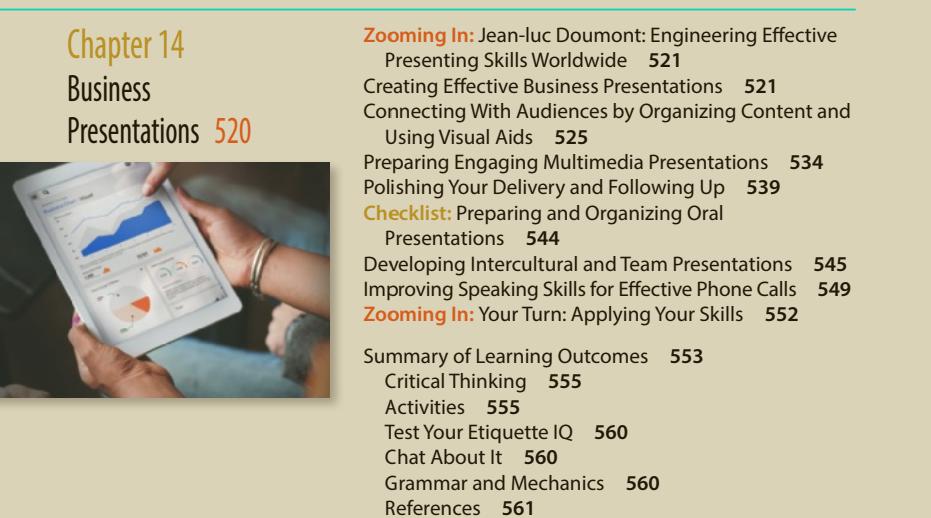
Assignment ch 13,
Answers this questions..- Explain the importance and purpose of proposals, and name the basic components of informal proposals !
- Explain the components of formal and grant proposals.
- Identify the components of typical business plans.
- Describe the components of the front matter in formal business reports, and show how they further the purpose of the report.
- ད་རིས་ཀྱི་བདུན་ཕྲག
14th session; Chapter 15. The Job Search, Resumes, and Cover Letters in the Digital Age.
After attending this lecture, students are expected to be able to:
- Begin a job search by recognizing emerging trends and technologies, exploring your interests, evaluating your qualifications, and investigating career opportunities.
- Develop savvy search strategies by recognizing how job seekers find their jobs and how they use digital tools to explore the open job market.
Expand your job-search strategies by using both traditional and digital tools in pursuing the hidden job market.
Organize your qualifications and skills into effective résumé categories, and use that information to prepare a personalized LinkedIn résumé.
Enhance your job search and résumé by taking advantage of today’s digital tools.
Understand the value of cover messages and how to draft and submit a customized message to highlight your candidacy.
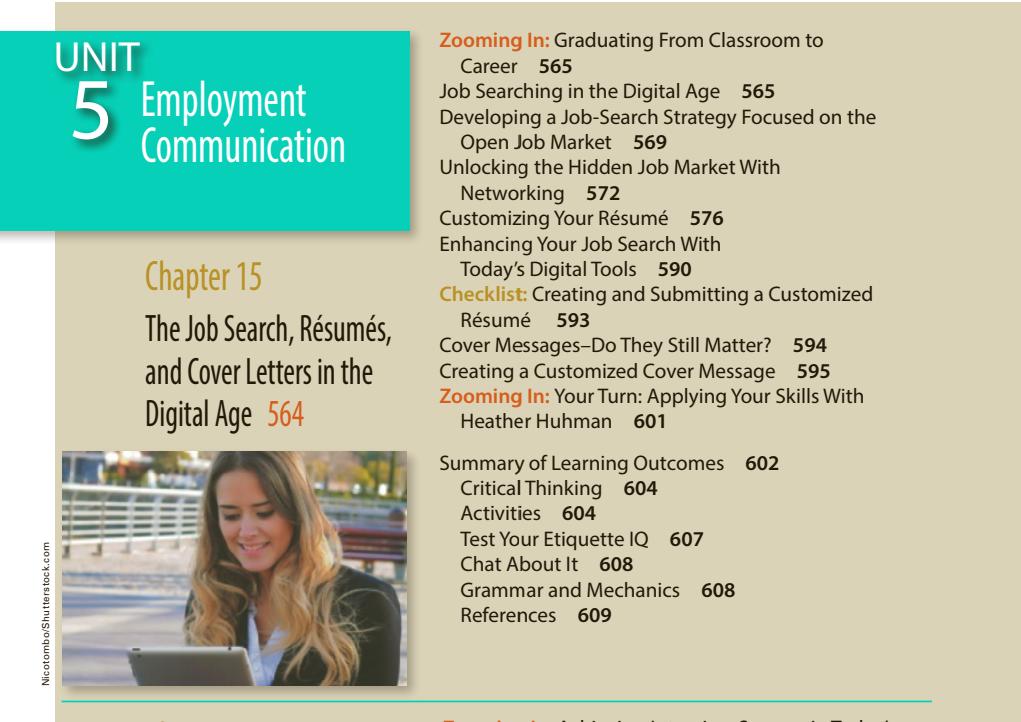
Answers this questions
1. How job seekers find their jobs and how they use digital tools to explore the open job market?
Expand your job-search strategies by using both traditional and digital tools in pursuing the hidden job market.
2. How to enhance your job search and résumé by taking advantage of today’s digital tools?
3. How to Understand the value of cover messages and how to draft and submit a customized message to highlight your candidacy.
15th session; Chapter 16. Interviewing and Following Up.
After attending this lecture, students are expected to be able to:
- Explain the purposes,sequence, and types of job interviews, including screening, one-on-one, panel, group, sequential, and video interviews.
- Describe what to do before an interview, including ensuring professional phone techniques, researching the target company, rehearsing success stories, cleaning up digital dirt, dressing properly, and fighting fear.
- Describe what to do during an interview, including controlling nonverbal messages and answering typical interview questions.
- Describe what to do after an interview, including thanking the interviewer, contacting references, and writing follow-up messages.
- Prepare additional employment documents such as applications, rejection follow-up messages, acceptance messages, and resignation letters.
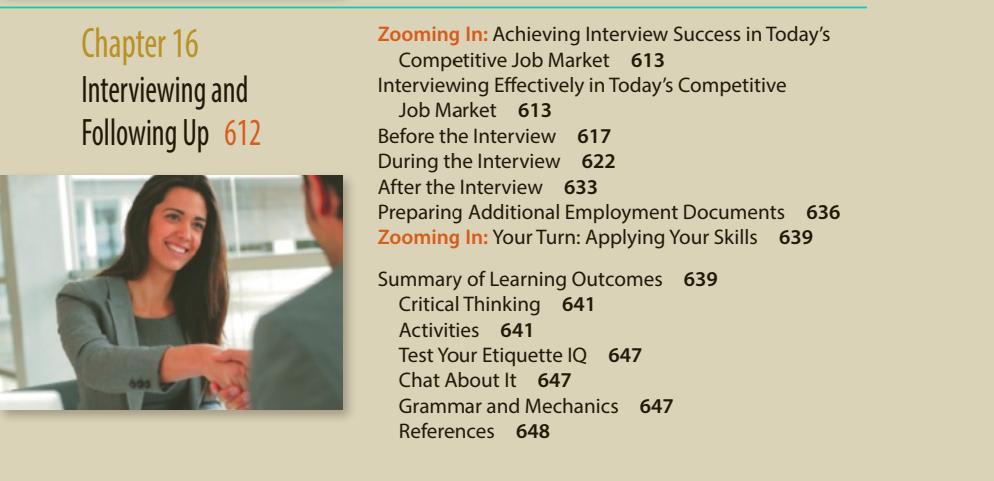
Answers this questions:
1. Explain the purposes,sequence, and types of job interviews, including screening, one-on-one, panel, group, sequential, and video interviews.
2. Describe what to do before an interview, including ensuring professional phone techniques, researching the target company, rehearsing success stories, cleaning up digital dirt, dressing properly, and fighting fear.
3. Describe what to do during an interview, including controlling nonverbal messages and answering typical interview questions.
4. Describe what to do after an interview, including thanking the interviewer, contacting references, and writing follow-up messages.
16th session; FINAL EXAM


